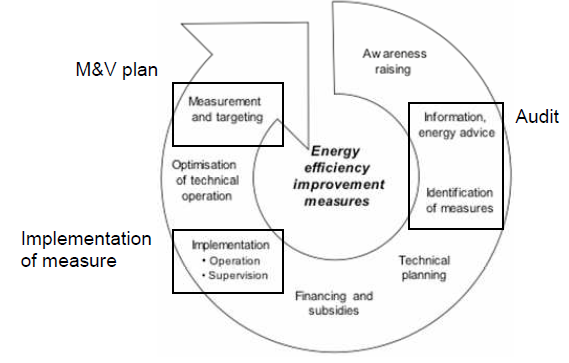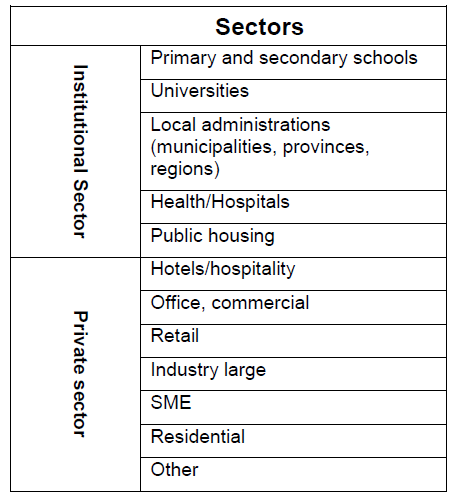| B2B | Business to Business means a contract
between two companies
Examples: housing companies,
municipality (public buildings), crafts
enterprises, Retail industry, property
developer rising up a settlement
|
| B2C | Business to Customer means a contract
between a company (e.g. EES provider)
and a private person
Examples: tenants, private single house
owners, private owners of small
multifamily houses, buyers of
prefabricated single houses
|
| Energy | All forms of commercially available energy,
including electricity, natural gas (including
liquefied natural gas), liquefied petroleum
gas, any fuel for heating and cooling
(including district heating and cooling),
coal and lignite, peat, transport fuels
(excluding aviation and maritime bunker
fuels) and biomass as defined in Directive
2001/77/EC of the European Parliament
and of the Council of 27 September 2001
on the promotion of electricity produced
from renewable energy sources in the
internal electricity market.
|
| Energy audit | A systematic procedure to obtain
adequate knowledge of the existing
energy consumption profile of a building or
group of buildings, of an industrial
operation and/or installation or of a private
or public service, identify and quantify
costıeffective energy savings
opportunities, and report the findings
(2006/32/EC).
Systematic inspection and analysis of
energy use and energy consumption of a
system or organisation with the objective
of identifying energy flows and the
potential for energy efficiency
improvement [prEN15900:2009]
|
| Energy consumption | Amount of energy used. |
| Energy efficiency | Ratio between an output of performance,
service, goods or energy, and an input of
energy [2006/32/EC and prEN
15900:2009]
|
| Energy efficiency improvement (EEI) | Increase in energy efficiency as a result of
technological, behavioural and/or
economic changes [prEN 15900:2009].
EEI relevant for the ChangeBest project
are only those that are increases in energy
end-use efficiency [i.e. applying the
definition of EEI in 2006/32/EC]
|
| EEI action | EEI action |
| Energy efficiency service (EES) | Agreed task or tasks designed to lead to
an energy efficiency improvement and
other agreed performance criteria [prEN
15900:900]. The agreement can relate to
the task and/or to the improvement. Other
agreed performance criteria can be
comfort level, production throughput,
safety, etc.
The EES shall be based on collected data
related to energy consumption. It shall
include energy audit as well as
identification, selection and
implementation of actions and verification.
A documented description of the proposed
or agreed framework for the actions and
the follow-up procedure shall be provided.
The improvement of energy efficiency
shall be measured and verified over a
contractually defined period of time
through contractually agreed methods
[prEN 15900:2009; cf. also Annex A of this
norm]
|
| Partial services connected to EES | Services that just include parts
(“components”) of the EES chain like
energy audits, but are designed to directly
or indirectly lead to an EEI.
|
| EESC | Energy Efficiency Service Company. An
entity that delivers EES.
Synonymously to ESCO, but with a
wording that makes clear that the
company focuses on EEI actions for their
customers.
[expression used by www.efiees.org]
|
| EES contract types: | a) supply contracting (focused on the
supply of a set of energy services mainly
via outsourcing the energy supply),
b) energy performance contracting (where
the EES providers use the stream of
income from the cost savings to repay the
costs of the project, including the costs of
the investment)
c) other contracting types (e.g. leasing,
Build-Own-Operate-Transfer (BOOT)
contracts, chauffage, etc.).
|
| EES provider | Any entity that delivers EES. Can be
synonymously used to “ESCO” or “EESC”.
|
| EES provider or provider of partial
services connected to EES
| Any entity that delivers EES or partial
services connected to EES.
Provider types:
Energy service company (ESCO)
Equipment manufacturer or supplier
Energy supply company
Energy distribution company Trading company (wholesale)
Multiutility company
Energy consulting company
Facility or property management
company
Equipment installer
Independent specialist company
Energy Agency
Bank
ESCO of a finance institution
Mix of some of the above
Other
In case of ESCOs it might be of use to
specify whether the ESCO is a public
ESCOs, private ESCOs, public-private
joint ventures, multinational companies
e.g. having or not heating and building
control equipment retailer origin,
independent specialist companies. |
| EES provider financing | Refers to financing with internal funds of
the EES provider (i.e. the EES provider is
the borrower) and may involve use of its
own capital or funding through other debt
or lease instruments
|
| EES value chain stages | 1) awareness raising,
2) information and energy advice,
3) identification of measures,
4) technical planning,
5) financing and subsidies,
6) implementation (operation, supervision),
7) optimisation of technical operation,
8) saving measurement and verification. *)
|
| Energy service | The physical benefit, utility or good derived
from a combination of energy with energy
efficient technology and/or with action (…)
which is delivered on the basis of a
contract and in normal circumstances has
proven to lead to verifiable and
measurable or estimable energy efficiency
improvement and/or primary energy
savings (2006/32/EC)
|
| ESCO | Any entity that delivers EES and in doing
so takes some kind of finanical risk and
meets some defined energy efficiency
performance criteria. (similar to
2006/32/EC).
In practice, “ESCO” is often used
synonymously to providers of energy
performance contracting.
Cf. also the definition of EESC and
definition of EES provider.
|
| Energy company | Company that deals with energy carriers.
It should be differentiated between energy
distributors, distribution system operators
and retail energy sales companies as
defined in the ESD
Among these, maybe further differentiating
between electricity, natural gas, or heat
companies or companies that deliver or
distribute more than one of these energy
carriers (combined).
|
| EPC | Energy performance contracting:
An EES which is paid for through energy
savings valuation.
Directive 2006/32/EC: A contractual
arrangement between the beneficiary and
the provider (…) of an energy
improvement measure, where investments
in that measure are paid for in relation to a
contractually agreed level of energy
efficiency improvement.
|
| Energy user/customer financing: | Usually involves financing with internal
funds of the energy user/customer backed
or not by an energy saving guarantee
provided by the EES provider (for instance
an university can use its endowment fund
to finance an energy project in which the
energy savings are guaranteed by an EES
provider). Energy-user/customer financing
may also be associated with borrowing in
the case when the energy-user/customer
as a direct borrower has to provide a
guarantee (collateral) to finance the
institution.
|
| Financing types | The ChangeBest project distinguish
between different financing types, e.g.:
EES provider financing, energy
user/customer financing and third-party
financing.
|
| Policy instruments | Categorisation:
1) Regulation
a) environmental permits (e.g. WBM)
b) standards (buildings and appliances)
2) Financial incentives
a) subsidies and fiscal facilities
b) taxes and special tariffs
3) Agreements
4) Market based instruments (WCS)
5) Communication/procurement/labels
6) Other
|
| Sectors | Sectors where EES may be provided: **) |
| Third-party financing (TPF) | Refers solely to debt financing. As its name
suggests, project financing comes from a third
party, e.g. a finance institution and not from
internal funds of EES provider or of the
customer. The finance institution may either
assume the rights to the energy savings or may take a security interest in the project equipment.
There are two conceptually different TPF
arrangements; the key difference between them
is which party borrows the money: the EES
provider or the Text |

